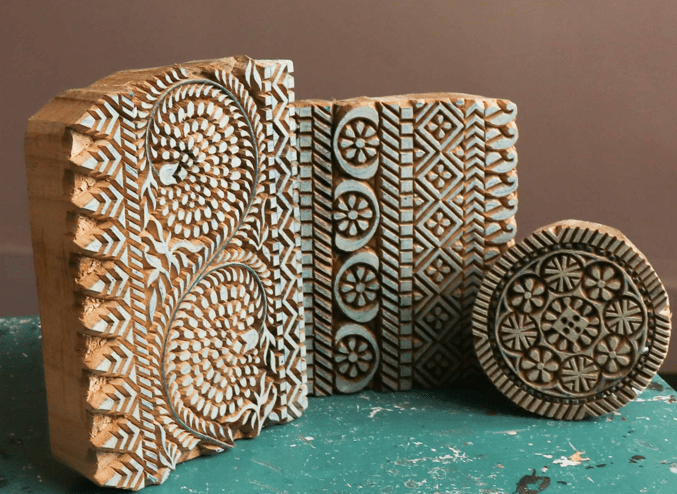Address
8/93, AC-BLOCK, SECOND STREET, ANNANAGAR, TAMILNADU CHENNAI-600040
Work Hours
Monday to Friday: 9AM - 7PM
Weekend: 10AM - 8PM

An image or pattern is carved onto a block of material, usually wood, linoleum, or rubber, in the traditional print making technique known as block printing. The design is transferred to paper or fabric by pressing the inked, carved block against those surfaces. Block printing lends the printed images a distinctive and handmade appearance.
Always use a gentle hand wash, swirl the fabric in cool or lukewarm water, and rinse thoroughly or on a delicate cycle during machine wash when washing items with hand-block prints. Avoid using severe detergents like bleach or harsh chemicals, as the prints can fade or damage the colours and delicate patterns. Use natural, mild detergents made especially for sensitive fabrics wherever possible.

When washing a new hand-block printed item for the first time, it’s advisable to use cold water as the colours may bleed or fade when exposed to hot water. Making use of cold water helps set the dyes and prevents excessive bleeding and fading. Subsequent washes can be done with lukewarm water if desired. During the wash of printed fabrics, it is recommended not to soak the fabric for a longer period of time in the water and steer clear of rough rubbing or scrubbing to prevent the colours from running.
Wash Dark and Light Hand Block Prints Separately to avoid colour bleeding. It’s advised to err on the side of caution to retain the brilliance of the prints because some colour dyes used in block printing may be somewhat unstable and bleed during the initial washes. Separating them will prevent any colour transfer to other garments.
If colour bleeding worries you, consider using colour-catching sheets or colour-absorbing cloths that capture stray dyes in the wash. These sheets can help keep the colours vivid and avoid colour transfer between items.
Avoid ironing directly on embroidery, block printing, etc. Such clothing needs to be pressed lightly and inside out. Urn hand block printed fabrics inside out before ironing to preserve the prints. Before ironing, cover the fabric with a small towel or pressing cloth to prevent direct heat contact, as too much heat can harm the printing.
Clothing with hand block printing should be hung inside or in a shaded place to dry naturally. Colours can fade over time if they are exposed to direct sunlight for long periods of time. A dryer should not be used since the heat can damage the delicate prints. The fabric can be laid flat on a spotless, dry surface or hung on a clothesline. Must avoid overexposure during the drying process and avoid exposing the fabric to the sun for a lengthy amount of time. Remove the cloth from the sun as soon as it is dry or nearly dry to avoid further exposure that can fade the colours.
Clothing should be kept in a dark, cool location away from direct sunlight. Keep white and light-coloured clothing separate from those that are darker in hue. Aromatic sachets can be used to eliminate cabinet odours. Do not fold them repeatedly, as this could fade or crease along the fold lines. As an alternative, gently roll them and place them in a ventilated cloth bag or wrap them in acid-free tissue paper. A better storage option is to roll the material.
Avoid using plastic bags: While it may be tempting to store clothing in plastic bags, doing so can cause mould or mildew to form. Instead, choose air-permeable cotton pillowcases or breathable fabric storage bags.
Avoid using aggressive chemical cleaners like bleach, powerful detergents, or spot removers on fabrics with hand-block printing. These compounds have the potential to fade the colours and alter the print’s overall appearance in general. One of the most important tips for hand-block printing is to avoid direct contact with perfume and body sprays when wearing hand-block printing clothing or anything that is alcohol-based. They contain chemicals that could damage the fabric by changing the design and the colours.
Consider hiring a professional dry cleaner for delicate or expensive hand-block printed items. They are skilled in handling delicate textiles and designs and guarantee optimum upkeep. Remember, when you take your hand-block printed fabric for professional cleaning, mention the nature of your dye or any known sensitivities or colour bleeding issues, as hand-block printed fabric often requires gentle treatment to preserve the colours and the patterns.
By following these tips, you can ensure that your hand-block printed garments remain protected and retain their beauty for years. You can extend the life of your hand-block printed items and enjoy their beauty for years to come.
Remember, each piece is a work of art; proper care will help preserve its uniqueness and charm.
UDDUP supplies pure fabric, which is printed with carved wooden blocks known as wooden block printings on fabric. They are printed with dyes with the vision of being an eco-friendly user of components during the printing process. The printing technique has been carried on since ancient times, carving the design on the block and later transferring the ink onto the fabric.
Visit our website or call us today to learn more about our block-printed Sarees & Fabrics.
